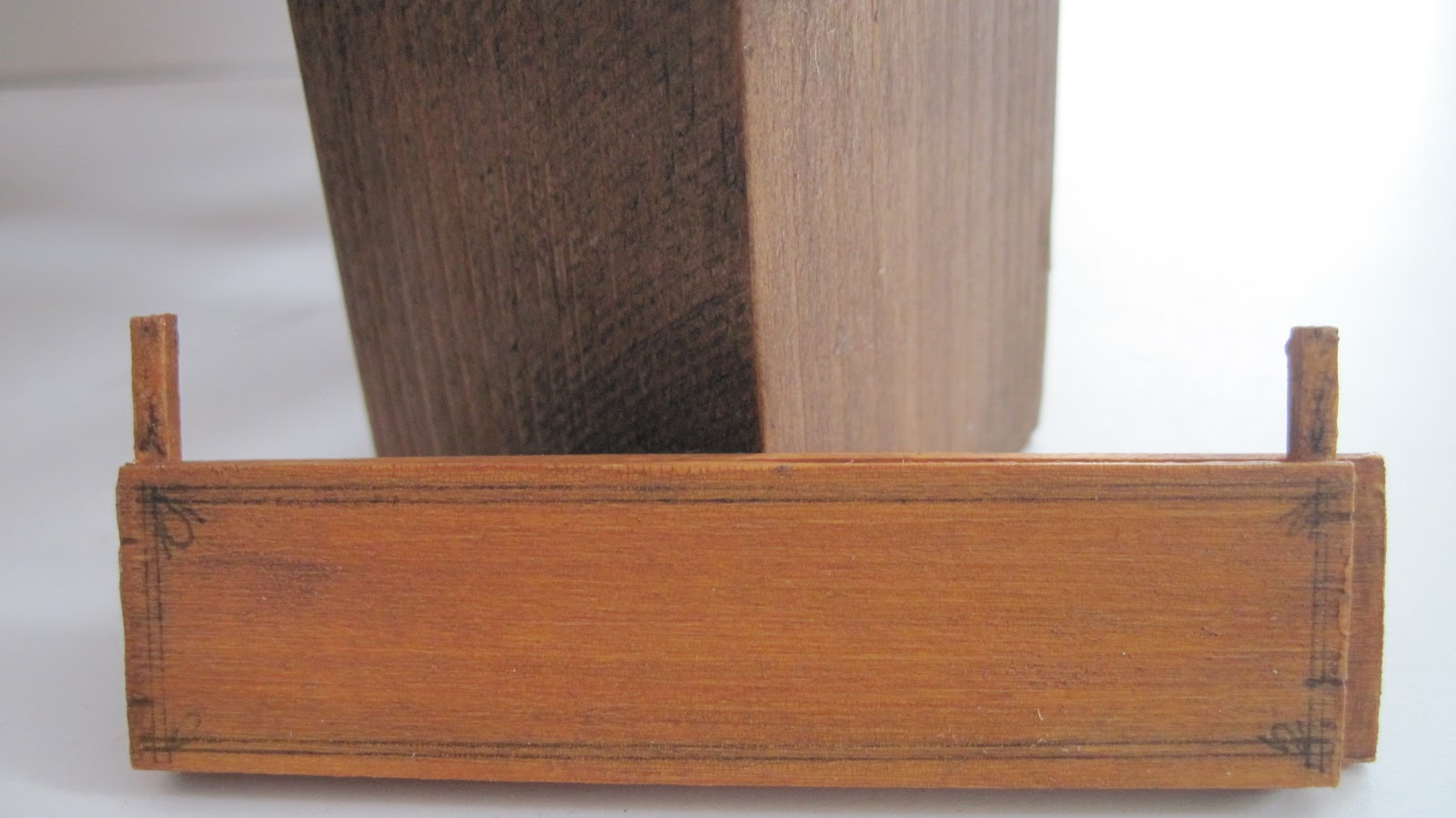The amount of time involved in making minis is directly related to how much time is spent waiting for glue and paint to dry. And the other thing is, how many times something has to be redone!
This is a gilder's cushion, with a tiny drawer underneath to hold the gold leaf bits that are applied to the more expensive books the bookbinder is working on. It measures 42 mm (1 3/16") wide, 21.5 mm (7/8")deep, and 1 cm (3/8") high at the side, has a padded suede leather top, and has brass "nails" (sequin centres or glitter!) along the edge of the cushion. It took 4 tries before the drawer stopped imploding; the fifth time it actually held. That took at least 3 days....
This peculiar item is called a "persknecht" in the Dutch instructions, which I think would translate to press aid in English; it appears to have something to do with the book press. There is another photo of this item below, it is actually 2 layers separated by square wooden pieces, which gives it a certain amount of springiness, or give. I used a #2.5 permanent black marker to draw the late Victorian/Early Edwardian decorative elements on it. I tried to research the press aid, without much luck, and if anyone knows what it is meant to be, please do let me know!
The work table has sturdy legs, and a fine beeswax finish. The block, most likely used for stamping designs into the leather book covers, has a veneer top, and like the table, a beeswax finish. I need to visit a bookbinder's shop to learn about the various tools used, so will do a little research to see if there is one in the area. With a couple of universities, there should be someone still re-building old and out-of-print books, and there are lots of artists in the area, as well.
Two of the walls for the bookbinder's shop have been cut, and I hope the others will soon appear on my work table. I'm thinking about how to decorate the interior; I rather like the idea of a late 19th or early 20th century scheme, lots of dark wood, anaglypta wallpaper, dark stairs with, perhaps, coconut matting, and imposing stair spindles and newel posts. I'll have to check scrapbooking shops to see if there is a good embossed paper to represent the anaglypta. We rented a house in Edmonton, AB for several years in the second half of the 70's, which dated from about 1910 (very, very old for Alberta!), which had olive-green anaglypta paper half-way up the hall and stair walls, my inspiration for this treatment for this little shop. We'll see!



Hello Marijke, the gilder's cushion has turned out very nice indeed.
ReplyDeleteThe persknecht is unknown to me too. I looked around and found this dutch site about a book binding group. They do not explain the persknecht itself but the proces with which you may need one. https://www.bbc-hetoudeambacht.nl/Lumbecken.htm
To sew all the seperate bindings together into one book they first need to be alligned properly. To that purpose they stick the paper upright with the back pointing downwards in a book press and put a clamp around it. Then they seperate pieces are alligned and fixed by the clamp.
You can not sew the back together when it rests on the bottom of the press so you hace turn it over. The clamp has to rest onto the book press. If the sheets are to wide and the clamp hovers above the press without touching it, you can add a persknecht to bridge the height difference.
If this is all it is used for or just one of the things you can do with it withoit the persknecht being intended for this use, I do not know. But this is all I have found so far. 🙂
Huibrecht
Thank you for checking that out for me; it makes sense as you explain it. I'm hoping someone at the university knows about old bookbinding techniques, so I can see for myself if there is a bindery in the area and check things out for myself. I will also check out the bookbinding group. Thank you so much! I am currently making books again, as I need books to clutter up the bindery....
Delete